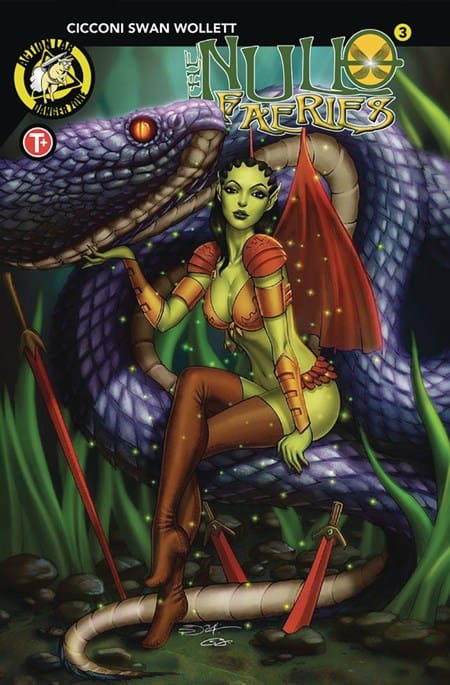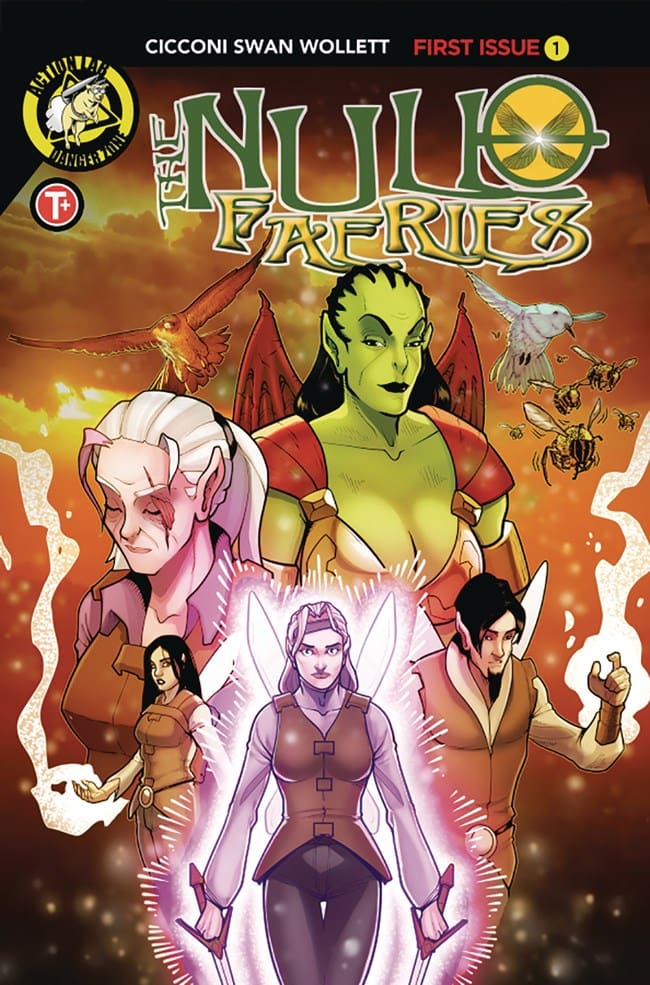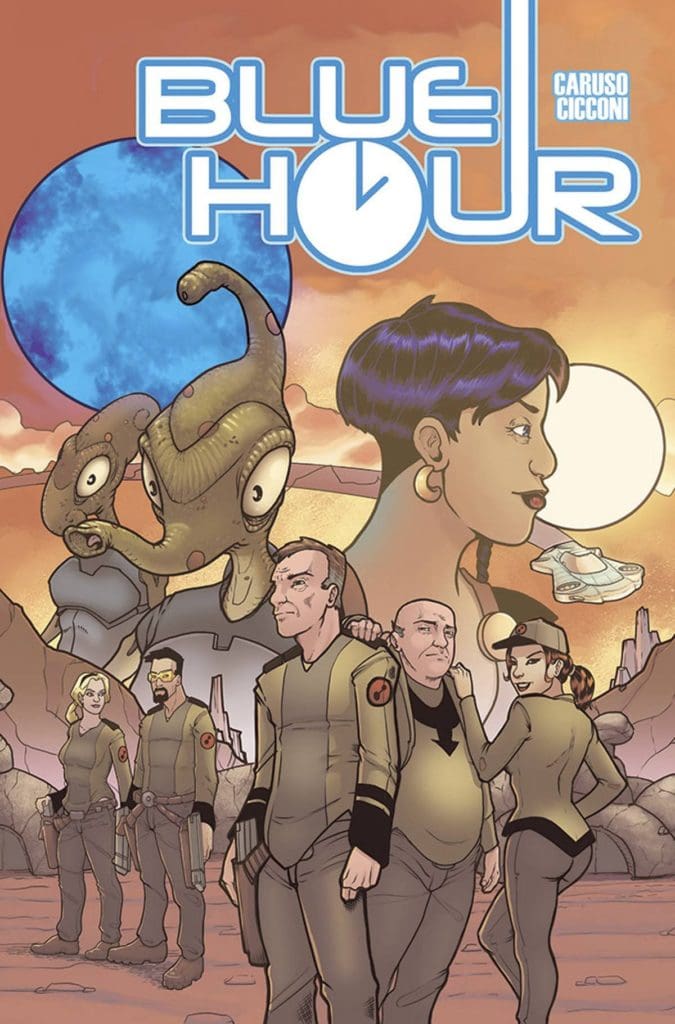Null Faeries is one of the latest new additions to Action Lab’s Danger Zone imprint. Created, written, and drawn by Chad Cicconi, Null Faeries tells a fantastical story of a forgotten champion, a wicked queen, and a crime of the century that could potentially send the Faeries world into ruin. I had the opportunity to talk with Chad about the book and gain some insight about this new world and characters he’s bringing to life.
To start off, can you tell me about the plot of this new story?
Sure, the short, 10-second elevator pitch is: Tinkerbell meets Silence of the Lambs. The longer synopsis is that this is a fairy story, and the main character is a tooth fairy – the greatest tooth fairy there is and she’s the Queen’s favorite.
One of the reasons I came up with this story is I always wondered in terms of the legend of “The Tooth Fairy” — what on Earth do fairies want with children’s teeth? Why are fairies collecting them? I never understood that. So I created a reason for that. In my world, the teeth are raw materials for the fairies to create magic dust – pixie dust – which is the backbone of the economy of the magical world. The role of the fairies is to gather, process, and create magic dust then distribute it to all the magic creatures of the world. So that’s why the tooth fairies are collecting it from the human children, and there are other fairy tribes that are kind of at war and fighting over this raw material.
The greatest of the tooth fairies, Ionantha, near the beginning of the story, she suffers a grievous wound during a battle with a dark fairy (someone from another tribe trying to take the teeth). This wound causes Ionantha to lose all of her magically abilities; she loses her wings, her ability to fly, she can no longer touch the fairy magic that all fairies are innately born with. She becomes an outcast; the only mortal fairy there has every been. She had to learn how to rely on her wits and cunning rather than magic, making her an incredibly intelligent fairy. This story takes place 90 years later, she’s an old woman – she still doesn’t age as quickly as humans do, but she’s an older woman – and a pixie dust shipment is hijacked and stolen, so she’s called back into service by the Queen to be her inquisitor and find out what happened to the shipment.
That’s awesome. I really like that idea that she’s not a human in the fairy world – it explains why she would have this understanding. Now, you touched on it a little bit, but what would you say is the biggest inspiration behind the story for Null Faeries? Has dark fantasy always been a genre you were interested in?
I don’t know if I would say specifically dark fantasy. I’ve always been a fantasy, sword and sorcery, fairytale, Dungeons and Dragons, Lord of the Rings, type person. That and comics and science fiction are what have been my fandoms and sort of the worlds I’ve walked through. So, the inspirations, like Tolkein and every fantasy novel I could find in Walden Books in the ’80s and ’90s – I couldn’t get my hands on those things fast enough – a million D&D campaigns over the years, and very literally, probably about 15 years ago, I was at dinner with some friends of my wife’s and mine and, I don’t even know how we got on the topic, but we started speculating about fairies and legends and we just spun it out of the course of the dinner, and it stuck in my head.
Then Action Lab was formed and I started doing comics myself and it was always stuck in the back of my mind as a story I wanted to see if I could tell. For many years I didn’t think my art was good enough to visually tell it, but finally after four or five other projects where I worked with writers and just did the art it came around. Then after I finished my most recent project, Blue Hour, I finally said, “if I don’t do this thing bouncing around in my head now, I’m never going to do it”, so I set about trying to outline and write it. This is the first project I’ve done as comic artist while writing it myself.
That’s crazy that a dinner conversation sparked all this and stuck with you like that. But that brings me to my next question, how did you come up with Ionantha Hesperis? What made you decide on a female lead?
Well, from the beginning it always felt to me like it should be a female lead. I like stories like Sherlock Holmes, where someone uses brainpower and their wits to conquer or succeed and I was always interested in what a female Sherlock Holmes would be like, and as I said, Silence of the Lambs meets Tinkerbell, Silence of the Lambs had a female protagonist.
And I sat down and I also thought, “Okay, what type of protagonist could we have in this book that hasn’t been done to death?” There have been a zillion comics with male protagonists and an increasing number with female protagonists, young women, like Princeless from Action Lab, so my thought was, “I would like to have an older woman as my main character.”
At this point with all the awareness that comics should be representative, that all different types of people that should be represented in comics, I still didn’t see a lot of comics with older women protagonists. So I came up with the plot device of being a mortal, aging fairy, living in a society where everyone is eternally 20-something and has all these wondrous powers that she doesn’t have. It added to the interest of the story. And in terms of the name, all of the names of all the fairy characters are based on plant species because the fairies are very in tune with nature and live amongst the trees and plants, so all of the fairy names are Latin or technical names for different plants. Ionantha is actually a type of African violet and her friends call her Violet – when she was younger she had pink-ish, violet hair, but as she’s aged her hair has turned white, but she still has a streak coming from her temple.
I would have never noticed that, I mean, obviously “Lily” is a flower name, but that definitely adds to the cleverness behind it. Which, talking about Lily, can you tell me anything about her? I really liked her so I hope you can at least tell me she’ll be coming back!
You are going to see Lily more past issue #1, she’s not one of the main character that’s driving the story, but she is a supporting character who is seen repeatedly in brief interludes later in the story. There are some flashbacks, obviously Lily had a key role in the events leading up to Violet’s injury, she was fighting there alongside her and brought her back to the Queen, those events will be reprieved at certain parts in the story because they have great significance in Ionantha’s life.
Well that’s good to know. And what about Lieutenant Betula? She is both Skyborne and Darkling, right? Is she the only one of her kind and is she a character we’ll see more explored?
Correct. She is someone who plays a key role in part of the story, things that occur with her drive parts of the rest of the story as well. I won’t say she’s the only one of her kind, but she is one of the few of her kind. Obviously he Groundlings, the Darklings are not on good terms with the Skyborne at this time and the Queen is a member of the Skyborne tribe. There are seven or eight different tribes in this world and they all have different attributes, magical powers, and motivations, they’re not all particularly good.
The Groundlings may or may not be evil, that’s up to the leader to decide, but for reasons that will be revealed later in the story, the Queen has limited the Groundlings allotment of pixie dust which the Groundlings aren’t particularly happy about, so they’re on the verge of going to war with the other tribes over this issue. Lieutenant Betula is a mixed heritage fairy from the Groundling and Skyborne tribes, so she’s in a unique, sometimes awkward, sometimes dangerous, position in fairy society.
That kind of segues me to what I wanted to ask next, the Groundlings kind of make me think of dragons and faeries blended together, was that intentional or just me? What gave you the idea?
I wanted to make them look a little more like creatures. Dragons were not in my mind when I was designing them, but certainly reptilian features were what I was thinking of when I was doing the design. One of the things the Groundlings do with their magic is they have a connection with some of the smaller woodland creatures. While the Skyborne can fly and manifest these ethereal fairy wings, the Groundlings and much more animalistic and they can commune with and controller these smaller creatures, which is a power the Skyborne don’t have. Some of the Groundlings do have wings, but it’s a physical attribute like bat wings, they can’t manifest these ethereal, glowing wings.
We know that humans, particularly their teeth, are valued in this world, that adults don’t know that these other beings exist, but when is this happening? Like, is it modern or older?
It’s actually a period piece, it begins in the mid 19th century and the remainder of the story takes place in the early 20th century. The first part when you see Ionantha as a young fairy at the height of her power takes place in the 1800s and then the arc takes place 90 years later in the 1900s. Fairies are largely immortal other than Ionantha, so I left myself open-ended enough so I can extend the universe and create different stories.
Yeah, I think having that flexibility will be nice when you start future stories. That was all the questions I had, was there anything you want to add before we finish up?
The thing I really want to add is that I have worked with a number of exceptional collaborators on this series, those include two colorists; the first two issues are colored by Eddy Swan, whose done a lot of other work for Action Lab, but his schedule didn’t permit him to finish the rest of the series, so issues #3-6 are colored by Federico Sioc, who I had been working with for several years, and his style is congruent enough with Eddy’s that it’s not a jarring change between them. I think they both knocked it out of the park and made my artwork look, frankly better than it deserves to. A lot of the heavy lifting on these books and these characters was due to the colorist.
You know, with fairies, there’s all these colors and lights, they have the little sparkles behind them, and in collaboration with the colorists I did all sorts of effects to draw the readers eye, and a lot of that work is done by the colorists. The lettering is done by Adam Wollett, who has done a lot of other work throughout the industry, he’s an exceptional letterer. And I also have to mention there are variant covers for each of the 6 issues done by Sorah Suhng who is amazing.
It makes me both excited and angry when I see her work because I like my own artwork and I did covers for each of the issues and I think they’re pretty darn good, and she out did me on several of the covers. Her covers are amazing and I’m thrilled I got her for this project, anybody reading this interview should definitely check out both of the covers – particularly for issue #4, I did a pose of Ionantha as she appears in the story and Sorah did a mirror cover of Ionantha in the same pose, but young, and those two covers next to each other are pretty amazing.
Well, there you have it. If you like fantasy, especially dark fantasy, make sure you check out Chad Cicconi’s Null Faeries at your local comic shop!





